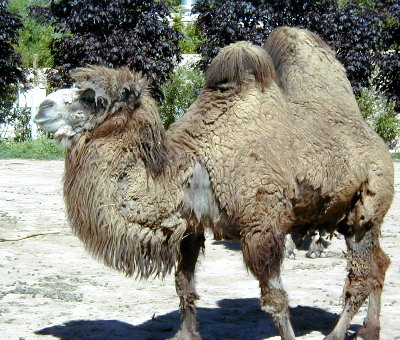
Camels are large mammals that live in dry areas. There are two types of camels: the one-humped camel (the Arabian Camel or Dromedary) and the two-humped camel (the Bactrian Camel). The Arabian camels are found in the very hot deserts of North Africa and the Middle East. Bactrian camels are found in the rocky deserts and steppes of Asia that get very hot and very cold.
The Hump: The camel's hump actually contains water and is the reason for their long travels in the desert without anything to drink. In some species, the camel contains a fat deposit made of glucose to keep it nurished. The camel can go without food and water for 3 to 4 days. It is well adapted to desert life.
Anatomy: Camels are very strong mammals with wide, padded feet. They have thick leathery pads on their knees and chest. Camels have nostrils that can open and close, protecting them from the desert environment. Bushy eyebrows and two rows of long eyelashes protect their eyes from sand. Their mouth is extremely tough, allowing camels to eat thorny desert plants. Camels are over 7 feet (2 m) tall at the hump and weigh in excess of 1,600 pounds (725 kg).
Diet: Camels are herbivores (plant-eaters). Most camels are domesticated and are fed by people; they eat dates, grass, wheat, and oats.
Classification:Class Mammalia (mammals), Order Artiodactyla, Suborder Tylopoda, Family Camelidae, Genus Camelus, Species C. dromedarius (dromedary camel) and C. bactrianus (Bactrian camel).